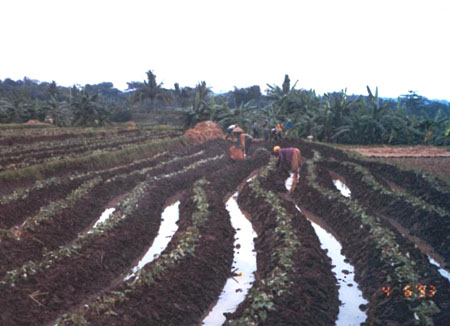|
Planting
time
Sweetpotato grows best in a season with abundant sunshine, but sufficient
water, either through rainfall or irrigation, to maintain soil moisture. In the
wet season, hours of full sunlight are suboptimal, humidity in the leaf canopy
can encourage fungal pathogens, and achieving sufficient soil drainage may be a
problem. However, with appropriate management, sweetpotato can be grown
throughout the year in many parts of the tropics.
Being a short-season crop (90-150 days in tropical lowlands), sweetpotato is
well suited to multiple crop systems. The planting time is then dependent on the
mix of other crops, and their demands. In much of South East Asia, sweetpotato
is grown after summer paddy rice, on land with insufficient irrigation access to
produce vegetables, maize or other more highly valued crops. In swidden (bush
fallow) farming systems, sweetpotato is seen as relatively tolerant of low
fertility, and is usually planted after the more demanding crops (yams, taro,
chili and other vegetables).
Planting
Method
A fter ridges or mounds are formed, the sweetpotato cuttings are
planted by burying the lower part in the top of the ridge or mound. A hole may
be made with a stick or by hand, and the soil gently pressed around the inserted
cutting. The stem is usually placed at an angle. Some workers claim that
cuttings oriented across the ridge yield better than those oriented along the
ridge.
In ridge planting systems, ridge spacing is typically 90-120 cm, and in-row
spacing is 20-30 cm (3-5 plants per meter). Generally, a higher plant density
results in lower yield per plant but higher yield per hectare. Close spacing is
used with short growing seasons, and wider spacing may be preferred where the
market prefers larger storage roots.
For mounds, the size and spacing of the mounds depends on soil conditions.
They may be 75-200 cm apart, and may be planted with several cuttings per mound.
Some farmers plant two cuttings at each station, but there is little evidence
that this is advantageous. It has been reported that single cuttings produce a
higher proportion of large storage roots.
References
Mohamed,
M. 1984. Effects of bed preparation and nitrogen fertilization on growth, yield
and quality of sweet potato (Ipomoea batatas) . Acta Hort. (ISHS)
143:311-318
http://www.actahort.org/books/143/143_35.htm.
22 August, 2002.
Rasco,
E.T., Jr. and Amante, V. 2000. Sweetpotato in Tropical Asia. SAPPRAD-PCARRD.
230 p.
van
de Fliert, E. and Braun, A. 1999. Farmer field school for integrated crop
management of sweetpotato. Field guides and technical
manual. International Potato Center. Lima, Peru. 266 p.
Contributed
by:
Vilma Amante
and
Jane O'Sullivan |
Land
preparation
Planting
material preparation
Soil
management
Water
management
Vine
lifting
Integrated
pest management
Harvesting
Postharvest
practices

Planting
in mounds in PNG (E.T. Rasco).

Planting
in rows in Indonesia (E.T. Rasco).

Planting
in slopes in the Philippines (V. Amante). |

